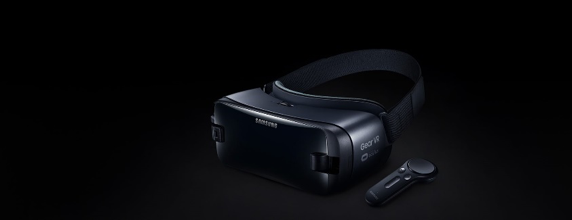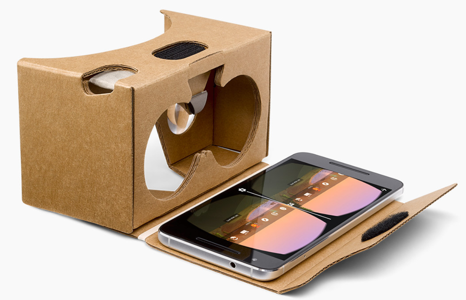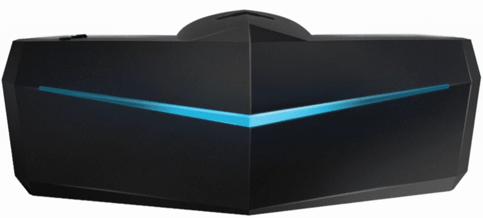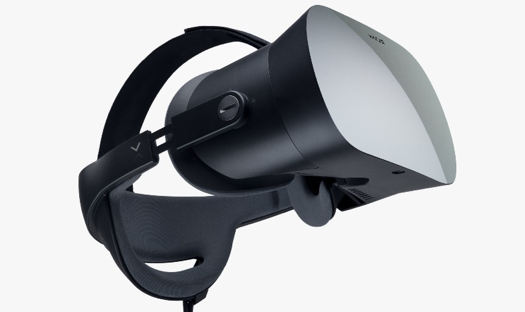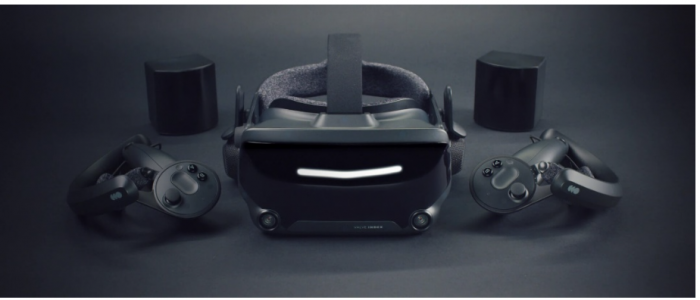Other HMDs
There are numerous other HMD brands such as Samsung GearVR, Nintendo Lab VR kit, Sony PlayStation VR, Lenovo Mirage, etc. with different specifications. Going into details about each and every one of these different brands would be out of the scope of this lecture. Notwithstanding, it would be of great interest to become familiar with some of the HMDs are go beyond the conventional specifications.
Although not new, Samsung’s GearVR is of the most affordable (but limited) HMDs. Instead of requiring the user to purchase his or her own computer, it works with various Samsung Galaxy phones. You can think of it as a fancier version of the Google Cardboard viewer. While the Cardboard viewer essentially works with every smartphone, the GearVR requires a Samsung phone although in its newest release the GearVR accepts a range of Samsung phones. While the Cardboard viewer is somewhat limited in its interactive capabilities (gaze and the little magnet button on the side), the GearVR has a back button and a little trackpad on the side. Computing power and display characteristics will depend on your phone.
While most VR HDMs have a field of view (FOV) of around 110 degrees, Pimax is an HMD with a FOV of 170-200 degrees (close to human vision). It has an 8K resolution (3840 x 2160 per eye) with a refresh rate of 80 Hz and is tethered. In addition to being compatible with a variety of controllers (e.g. HTC Vive controllers), Pimax has a special Leap Motion module embedded in the HMD. This module provides real-time and accurate hand tracking and can enable users to solely use their hands as the interaction modality. Furthermore, as another addition to its modular system, Pimax utilizes an eye-tracking module that can provide real-time tracking of users’ eye movements while interacting with a VR experience. Such information will be useful for an array of research topics, including usability studies, user-behavior analysis, and learning content adaptation. The high FOV provided by Pimax enable users to perceive the virtual environment in a way much closer to real life. This can potentially set the basis for more effective training of visual-spatial skills in VR and a more successful transfer of these skills to real-world contexts.
As is evident from the different HMDs we have seen so far, the resolution of these devices has improved significantly over the past few years. Notwithstanding, they are still not comparable to high-end desktop experiences in that respect. As one of the main applications of VR HMDs is training via realistic simulations, display quality and high-resolution imagery can play a determining role in the successful realization of learning goals in these applications. For this exact reason, the Varjo company has released a VR HMD called Varjo VR-1. Standing at almost 6000$, it is one of the most expensive HMDs in the market, but it possesses unique characteristics. It has a Bionic display – human eye-like resolution of 60 Pxl per degree and combines a 1920x1080 low-persistence micro-OLED and a 1440x1600 low-persistence AMOLED. It is important to note that this HDM is not targeted at average consumers, but rather for AEC (architecture, engineering, and construction), industrial design, virtual production, healthcare, and training and simulation. Given the fact that resolution is one of the drawbacks of VR which impedes its proper utilization in simulations and application where detailed graphical elements are important (e.g. creation of artwork in VR, reading long texts in VR, surgery simulation, interacting with a cockpit panel with lots of buttons and small labels, etc.), this HDM opens the door for interesting research opportunities. Furthermore, it has a built-in eye-tracking module that provides researchers with a great opportunity to monitor the behavior of users when interacting with a VR experience for the purposes of usability studies, measurements of attention/interest, user behavior studies, and content adaptation.
The bottom line is that there is a tremendous amount of development on the VR market that is spurring developments in industry and academia. We just gave you a little glimpse of some of the most prominent examples but there are many, many more. To further acquaint you with some of the technologies we have two tasks outlined on the next page.
On June 28th, 2019, Valve released the first of their second-generation HMDs called Index. Valve Index has a display resolution of 1440 x 1600 per eye and a refresh rate of 120 Hz. Valve index is backward compatible with all HTC products including the Vive HMDs and the lighthouses (base stations used for tracking). It comes with a new generation of the lighthouse sensors (base station 2.0) that offer improved tracking range, better field of view, and potentially a 300 percent larger tracking space. Perhaps one of the most delightful features of the Valve Index is the novel controllers (called Knuckles) that are significantly more ergonomic compared to other controllers on the market.
